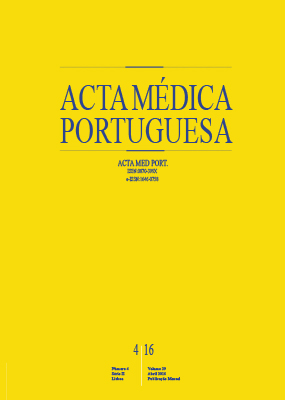Complete Ureteral Duplication: Outcome of Different Surgical Approaches
DOI:
https://doi.org/10.20344/amp.6329Keywords:
Nephrectomy, Ureter/abnormalities, Ureter/surgery, Vesico-Ureteral Reflux.Abstract
Introduction: The surgical management of complete ureteral duplication anomalies is not consensual.
Objective: To characterize the pediatric population who underwent surgery for complete ureteral duplication and assess the outcomes of different approaches.
Material and Methods: Clinical records from patients treated between January 2008 and June 2014 were retrospectively reviewed. Epidemiology, diagnosis, clinical manifestations and surgical procedures were collected and analysed. Ureteral units were divided into two groups: A, with ureterocele; and B, without it.
Results: Forty-one ureteral units from 32 patients with complete duplication underwent surgery. In group A (n = 18), the selected primary procedure was: ureterocele punction (12); ureter reimplantation (3); pyelopyelostomy (2); heminephrectomy (1). A reintervention was required in 3 of the 12 units submitted to punction: heminephrectomy (1), ureteroureterostomy (1), and ureteric reimplantation (1). In group B (n = 23), STING was performed in 10 units, ureteric reimplantation in 3, pyelopyelostomy in 3, ureteroureterostomy in 1, and heminephrectomy in 6; two cases required reintervention.
Discussion: A conservative primary approach was favoured in cases with ureterocele and/or reflux in hemisystems worth preserving (53.7%); it was effective per se in 75% (n = 9/12) units in group A and 80% (n = 8/10) in group B. An ablative primary procedure was adopted in 17% (n = 7/41) cases, 5.6% of group A (n = 1/18) and 26.1% of group B (n = 6/23).
Conclusions: A conservative approach is effective as a primary and isolated procedure in the majority of cases with ureterocele or vesicoureteral reflux. Further studies are needed to establish the advantages over primary invasive or ablative approaches.
Downloads
Downloads
Published
How to Cite
Issue
Section
License
All the articles published in the AMP are open access and comply with the requirements of funding agencies or academic institutions. The AMP is governed by the terms of the Creative Commons ‘Attribution – Non-Commercial Use - (CC-BY-NC)’ license, regarding the use by third parties.
It is the author’s responsibility to obtain approval for the reproduction of figures, tables, etc. from other publications.
Upon acceptance of an article for publication, the authors will be asked to complete the ICMJE “Copyright Liability and Copyright Sharing Statement “(http://www.actamedicaportuguesa.com/info/AMP-NormasPublicacao.pdf) and the “Declaration of Potential Conflicts of Interest” (http:// www.icmje.org/conflicts-of-interest). An e-mail will be sent to the corresponding author to acknowledge receipt of the manuscript.
After publication, the authors are authorised to make their articles available in repositories of their institutions of origin, as long as they always mention where they were published and according to the Creative Commons license.









